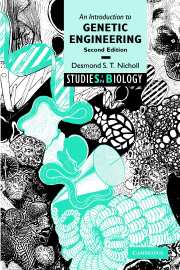Book contents
- Frontmatter
- Contents
- Preface to the second edition
- 1 Introduction
- Part I The basis of genetic engineering
- Part II The methodology of gene manipulation
- Part III Genetic engineering in action
- 9 Understanding genes and genomes
- 10 Genetic engineering and biotechnology
- 11 Medical and forensic applications of gene manipulation
- 12 Transgenic plants and animals
- 13 The other sort of cloning
- 14 Brave new world or genetic nightmare?
- Suggestions for further reading
- Using the World Wide Web
- Glossary
- Index
13 - The other sort of cloning
Published online by Cambridge University Press: 05 June 2012
- Frontmatter
- Contents
- Preface to the second edition
- 1 Introduction
- Part I The basis of genetic engineering
- Part II The methodology of gene manipulation
- Part III Genetic engineering in action
- 9 Understanding genes and genomes
- 10 Genetic engineering and biotechnology
- 11 Medical and forensic applications of gene manipulation
- 12 Transgenic plants and animals
- 13 The other sort of cloning
- 14 Brave new world or genetic nightmare?
- Suggestions for further reading
- Using the World Wide Web
- Glossary
- Index
Summary
On 5th July 1996 a lamb was born at the Roslin Research Institute near Edinburgh. It was an apparently normal event, yet it marked the achievement of a milestone in biological science. The lamb was a clone, and was named Dolly. She was the first organism to be cloned from adult differentiated cells, which is what makes the achievement such a ground-breaking event. In this chapter we will look briefly at this area of genetic technology.
In this book so far, we have been considering the topic of molecular cloning, where the aim of an experimental process is to isolate a gene sequence for further analysis and use. In organismal cloning, the aim is to generate an organism from a cell that carries a complete set of genetic instructions. We have looked at the methods for generating transgenic organisms in Chapter 12, and a discussion of organismal cloning is a natural extension to this, although transgenic organisms are not necessarily (and at present are not usually) clones. In a similar way, a clone need not necessarily be transgenic. Thus, although not strictly part of gene manipulation technology, organismal cloning has become a major part of genetics in a broader sense. The public have latched on to cloning as an issue for concern, and thus a discussion of the topic is essential even in a book where the primary goal is to illustrate the techniques of gene manipulation.
Early thoughts and experiments
The announcement of the birth of Dolly in a paper in the journal Nature in February 1997 rocked the scientific community.
- Type
- Chapter
- Information
- An Introduction to Genetic Engineering , pp. 247 - 258Publisher: Cambridge University PressPrint publication year: 2002

